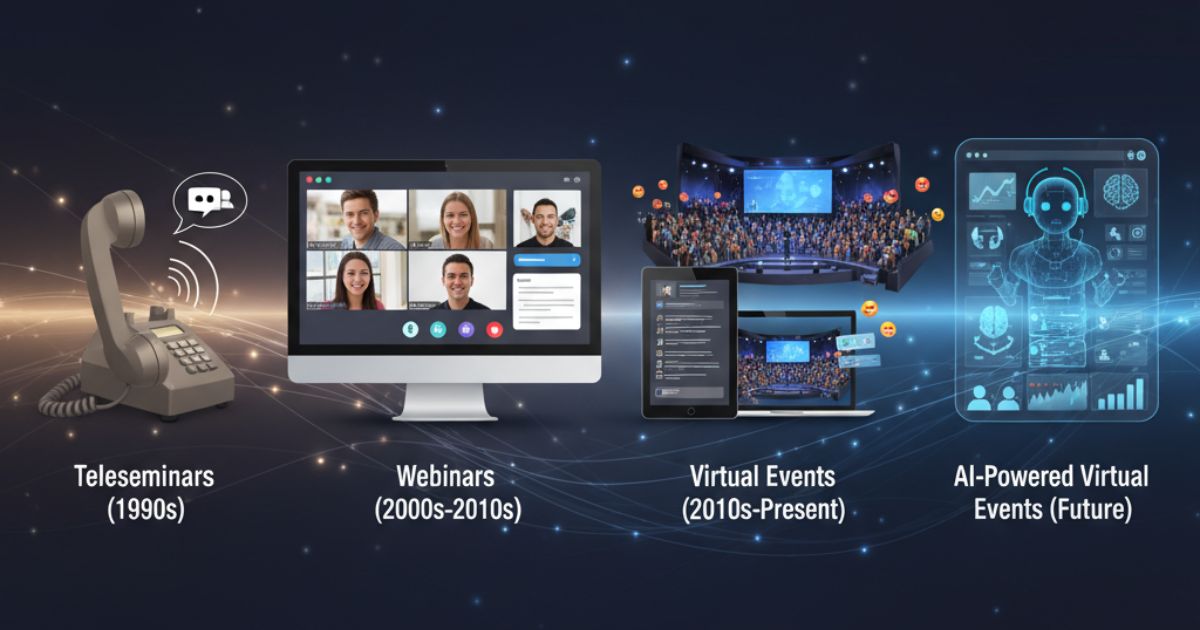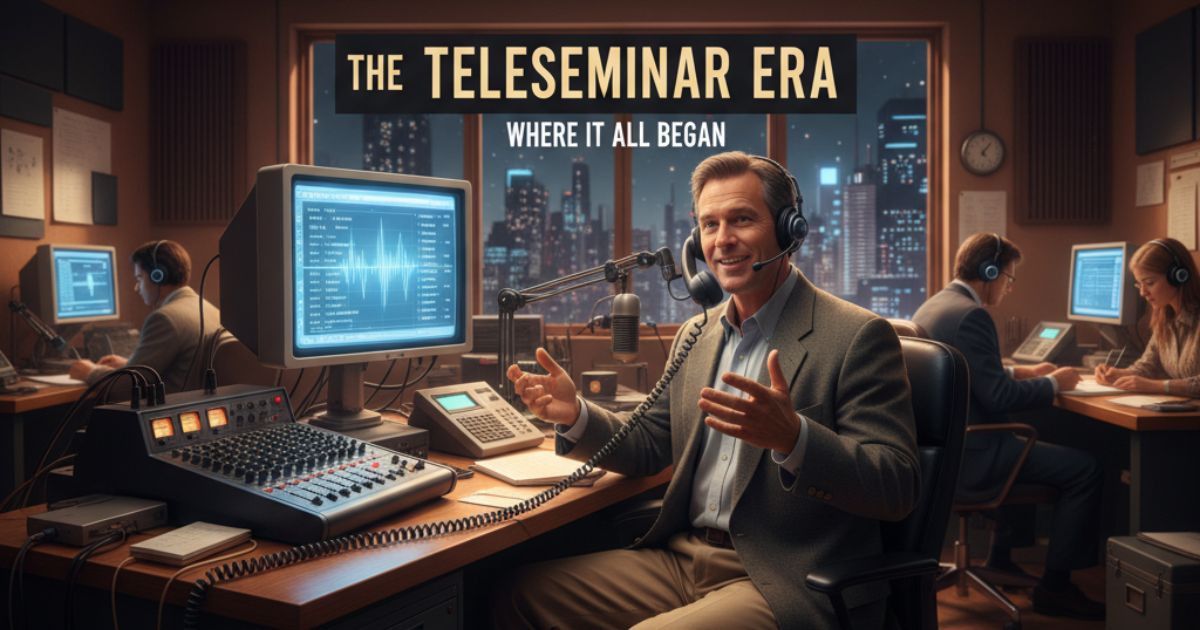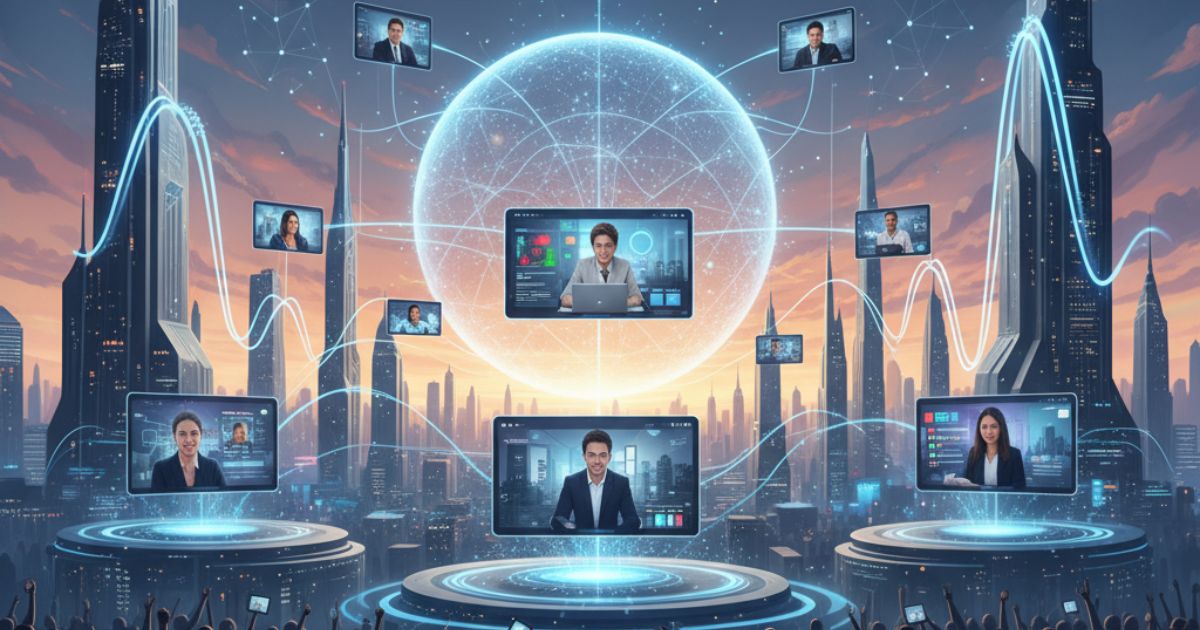
Webinars have undergone a remarkable transformation since their early days as teleseminars—simple, audio-only conference calls used for training, sales presentations, and remote learning. What once relied solely on telephone lines has evolved into high-quality, interactive virtual events capable of engaging hundreds or even thousands of global participants in real time.
This evolution mirrors major shifts in digital communication technology, remote work culture, and content consumption behavior. As platforms like Zoom, Microsoft Teams, GoToWebinar, and Webex advanced, so did audience expectations—paving the way for AI-powered webinar platforms, automated engagement tools, and immersive virtual experiences.
Understanding this journey reveals not just how webinars developed, but also where they’re heading. From basic teleseminars to today’s AI-driven virtual events, each stage has unlocked new opportunities for business growth, online education, marketing automation, and remote collaboration.
The Teleseminar Era: Where It All Began
Before high-speed internet, streaming video, or modern webinar platforms existed, the teleseminar reigned as the primary tool for remote presentations and virtual communication. These early audio-only online events relied on basic conference call systems, allowing hosts to connect with dispersed audiences without needing a physical venue or expensive equipment.
For its time, the teleseminar was groundbreaking. Corporate training teams could onboard employees across multiple offices without travel costs. Universities and continuing education providers used phone-based lectures to bring in guest instructors from anywhere in the world. Direct response marketers, coaches, and consultants discovered they could build audiences, nurture leads, and sell high-ticket programs using nothing more than a telephone bridge line.

But teleseminars also came with major limitations. Without visual content, presenters struggled to maintain attention and deliver engaging experiences. Technical issues—like poor audio quality, line echo, and dropped calls—were frequent. Engagement was minimal, typically limited to a short Q&A segment at the end. As audience sizes grew, managing interaction became increasingly difficult.
The Birth of Modern Webinars
The widespread adoption of broadband internet in the early 2000s marked a major turning point in virtual communication. As online connectivity improved, **web-based seminars—later known as webinars—**emerged as the natural evolution of traditional teleseminars. Unlike audio-only conference calls, webinars blended live video, slide presentations, and screen sharing, creating a more dynamic and interactive format.
Early platforms such as WebEx, GoToWebinar, and later Adobe Connect introduced features like:
-
Real-time screen sharing
-
PowerPoint slide integration
-
Basic chat, polls, and Q&A tools
-
Presenter video feeds
This shift allowed hosts to visually demonstrate ideas, workflows, and product features—something teleseminars couldn’t achieve. Presenters could show charts, dashboards, UI walkthroughs, animations, and live demos, making complex information easier to communicate.
For businesses, educators, and marketers, the impact was transformative. Product demos became more compelling, remote training programs more effective, and online workshops more engaging. The ability for audiences to see facial expressions, gestures, and on-screen content created a richer, more human virtual experience.
This stage laid the foundation for the modern webinar ecosystem—one built on interactivity, visual learning, and real-time engagement.
The Rise of Dedicated Webinar Platforms

As virtual communication matured, the demand for more robust and scalable online event solutions led to the emergence of dedicated webinar platforms. Tools that once seemed cutting-edge quickly evolved into full-featured environments designed for live events, virtual conferences, online training, and marketing webinars.
Platforms like Zoom, Microsoft Teams, Webex, GoToWebinar, Demio, and BigMarker became industry staples—each serving a unique segment of the market.
Zoom reshaped the webinar landscape with its intuitive interface, high-quality video, and exceptional reliability. Microsoft Teams extended its collaboration ecosystem by integrating webinar and live event functionality directly into its productivity suite. Meanwhile, Demio and BigMarker targeted marketers with advanced automation tools, analytics dashboards, and event funnels optimized for lead generation.
These platforms introduced features that were unimaginable during the teleseminar era, including:
-
Breakout rooms for small-group discussions
-
Live polls and instant surveys for real-time audience insights
-
Q&A modules and chat streams to boost engagement
-
Virtual whiteboards and interactive screen sharing
-
High-definition recording and cloud-based event replay
-
CRM and marketing automation integrations with tools like HubSpot, Salesforce, and Marketo
This new generation of webinar software democratized online events. Small businesses, startups, and independent creators gained access to the same enterprise-grade tools used by Fortune 500 companies—without needing technical teams or large budgets. Thought leaders, educators, and marketers could now deliver professional, interactive webinars that felt polished and scalable.
The rise of these platforms laid the groundwork for the next evolution: hyper-personalized, AI-powered virtual events capable of supporting global audiences at unprecedented levels of quality and engagement.
Virtual Events: Scaling Beyond Traditional Webinars
The COVID-19 pandemic dramatically accelerated the adoption of virtual events and pushed the limits of what online experiences could achieve. Organizations that once relied on in-person conferences, trade shows, workshops, and corporate training suddenly had to shift entire programs into the digital space.
This rapid transformation fueled a wave of innovation across virtual event platforms. Tools like Hopin, Zoom Events, ON24, Airmeet, and vFairs introduced immersive features designed to mirror the atmosphere of physical gatherings. Attendees could enter virtual lobbies, explore interactive exhibition halls, join networking lounges, and navigate multi-session agendas tailored to their interests—much like navigating an offline conference.
These enhancements marked a major leap beyond traditional webinars. Instead of relying solely on one-to-many presentations, virtual events enabled:
-
Session tracks and customizable schedules
-
1:1 video networking and AI-powered matchmaking
-
Sponsor booths and branded expo areas
-
Gamification elements for higher engagement
-
Real-time analytics dashboards for event organizers
One of the most significant advantages was scale. Without the constraints of venue size, travel budgets, or time zones, organizations could reach global audiences faster and more efficiently. Attendance surged as participants from different regions joined with just a click, boosting overall reach, engagement, and ROI.
This shift established virtual events as a core component of modern digital communication—and set the stage for today’s AI-enhanced hybrid and virtual experiences.
AI Integration: The Current Frontier
Artificial intelligence has become the defining force behind the next generation of webinars and virtual event platforms. Modern tools are embedding AI capabilities to streamline event management, boost audience engagement, and deliver deeper insights for presenters, marketers, and event organizers.
AI-powered transcription and real-time closed captioning now provide instant, highly accurate subtitles—dramatically improving accessibility and compliance for diverse global audiences. Advanced engagement analytics evaluate viewer behavior in real time, identifying which slides, topics, and moments generate the most interest or drop-off. This helps hosts refine their messaging and optimize content delivery.
Intelligent scheduling tools leverage AI to determine the ideal time for hosting webinars based on attendee time zones, historical attendance data, and audience preferences. Some platforms even offer AI-driven content recommendations, automatically guiding participants toward sessions that align with their interests, behavior, and industry role.
Automation extends far beyond the event itself. AI follow-up systems can send personalized resources, nurture emails, session recordings, and meeting invitations based on each attendee’s engagement score. This transforms webinars into powerful revenue and conversion engines.
During live sessions, AI chatbots are now capable of answering FAQs, managing routine interactions, and providing helpful navigation—all without disrupting the flow of the event. Combined with instant AI translation and multilingual support, these tools break down language barriers and enable truly global participation.
Together, these innovations mark a significant leap forward, elevating webinars from simple online presentations to data-driven, intelligent, and highly personalized virtual experiences.
The Impact on Business and Education
The rapid evolution of webinar technology has fundamentally transformed how organizations communicate, train, and market in a digital-first world. Businesses across industries now rely on virtual platforms to deliver high-impact experiences at scale—without the limitations of physical presence.
Sales teams host live product demonstrations for prospects worldwide, accelerating deal cycles and reducing travel time. HR departments use interactive onboarding sessions to train and support new employees, even in remote or hybrid work environments. Marketing teams leverage educational webinars to attract qualified leads, nurture customer relationships, and build thought leadership.
Education has experienced an equally profound shift. Schools, universities, and professional training programs have integrated virtual presentations into their core learning models. Industry experts can deliver guest lectures from anywhere in the world, while professional development courses reach working adults who need flexible, accessible learning options.
Beyond engagement and accessibility, the financial impact is significant. Organizations save on venue rentals, travel, accommodation, catering, and logistical costs traditionally associated with in-person events. These savings compound over time, making virtual events an essential part of modern business strategy.
The environmental benefits are equally meaningful. By reducing corporate travel and physical event requirements, organizations lower their carbon footprint, contributing to more sustainable operations while still delivering high-quality experiences.
Looking Ahead: The Future of Virtual Events
The future of virtual events is moving toward deeper immersion, smarter automation, and hyper-personalized digital experiences. As webinar technology evolves, AI-powered tools, immersive media, and next-generation analytics will transform how businesses, educators, and creators deliver online presentations.
Virtual reality (VR) will enable fully immersive virtual conferences, allowing attendees to explore 3D expo halls, join interactive breakout rooms, and network through lifelike avatars. Augmented reality (AR) will enhance product demos and training sessions, blending digital overlays with physical environments for clearer, more engaging explanations.
AI-driven analytics will reshape how presenters understand audience behavior. Machine learning models will analyze engagement patterns, predict attention levels, and even adjust presentation pacing, visuals, and difficulty in real time. This leads to smarter virtual events where content automatically adapts to attendee needs.
Blockchain technology may introduce secure methods for content ownership, ticketing, and digital rights management, giving hosts more protection and flexibility when distributing webinar recordings or premium sessions.
IoT-powered hybrid experiences will merge the physical and virtual worlds. Smart devices could optimize lighting, sound, temperature, and screen settings based on the type of webinar or event being viewed, creating a personalized and comfortable experience for every participant.
As these technologies converge, virtual events will become more immersive, intelligent, and interactive—unlocking new opportunities for remote training, digital marketing, online learning, and global collaboration.
This next phase marks the shift from traditional webinars to AI-driven, experience-rich virtual events that feel dynamic, seamless, and deeply engaging.
Maximizing Your Virtual Event Strategy
The rapid evolution of webinar and virtual event technology offers powerful opportunities for organizations that adopt these tools with a strategic mindset. Today’s digital-first environment requires more than simply converting in-person presentations into online sessions. High-performing virtual events take advantage of the unique strengths of digital platforms—automation, analytics, interactivity, and global reach—while minimizing the limitations of remote communication.
Engagement is the foundation of an effective virtual event strategy. Features such as live polls, interactive Q&A, breakout rooms, chat conversations, and real-time feedback tools help recreate the energy of in-person experiences. These interactive elements boost attention, improve knowledge retention, and make webinars more collaborative.
Content longevity is another competitive advantage. By recording sessions and converting them into on-demand webinars, short video clips, training modules, podcast-style audio, or downloadable resources, organizations extend the life and impact of each event. Repurposed content increases audience reach, improves lead generation, and provides long-term value for marketing, sales, HR, and education teams.
As webinar platforms continue to integrate AI-powered features, personalization engines, automation workflows, and advanced analytics, organizations that stay current with emerging capabilities will remain ahead of competitors. The shift from basic teleseminars to intelligent, AI-enhanced virtual events is only the beginning. Those who proactively refine their virtual event strategy will unlock stronger audience engagement, better insights, and more scalable digital communication across their entire organization.
FAQs
1. What is the difference between a teleseminar and a webinar?
A teleseminar is an audio-only conference call, while a webinar is a web-based seminar that includes video, slides, screen sharing, and interactive tools. Modern webinar platforms like Zoom, Webex, GoToWebinar, Demio, and Microsoft Teams offer features such as chat, polls, and breakout rooms—things teleseminars could never support.
2. How have webinars evolved over time?
Webinars have evolved from simple phone-based teleseminars into advanced AI-powered virtual events with automation, analytics, real-time engagement features, and immersive environments. Innovations like AI transcription, breakout rooms, HD video, CRM integrations, virtual expo halls, and personalized event journeys are now standard.
3. What industries benefit most from modern webinar technology?
Sectors such as education, SaaS, HR & learning development, healthcare, finance, marketing, and professional training rely heavily on webinars for remote communication. Webinars support sales demos, employee onboarding, virtual classrooms, certification training, and thought-leadership events.
4. What makes a virtual event different from a traditional webinar?
A webinar is typically a one-to-many online presentation, but virtual events include multi-session agendas, networking lounges, sponsor booths, AI matchmaking, and interactive expo halls. Platforms like Hopin, Zoom Events, ON24, Airmeet, and vFairs enable conference-like experiences online.
5. How does AI improve webinars and virtual events?
AI enhances webinars by offering:
-
Real-time transcription & captions
-
Engagement analytics (attention score, drop-off points)
-
Automated follow-up emails & lead scoring
-
Session recommendations for attendees
-
AI chatbots to manage FAQs and support
-
Instant translation for multilingual audiences
These features increase accessibility, personalization, and overall event performance.



















No Comments